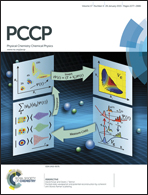Katoite under pressure: an ab initio investigation of its structural, elastic and vibrational properties sheds light on the phase transition
Abstract
The evolution under pressures up to 65 GPa of structural, elastic and vibrational properties of the katoite hydrogarnet, Ca3Al2(OH)12, is investigated with an ab initio simulation performed at the B3LYP level of theory, by using all-electron basis sets with the Crystal periodic program. The high-symmetry Ia3d phase of katoite, stable under ambient conditions, is shown to be destabilized, as pressure increases, by interactions involving hydrogen atoms and their neighbors which weaken the hydrogen bonding network of the structure. The corresponding thermodynamical instability is revealed by anomalous deviations from regularity of its elastic constants and by numerous imaginary phonon frequencies, up to 50 GPa. Interestingly, as pressure is further increased above 50 GPa, the Ia3d structure is shown to become stable again (all positive phonon frequencies and regular elastic constants). However, present calculations suggest that, above about 15 GPa and up to at least 65 GPa, a phase of I![[4 with combining macron]](https://www.rsc.org/images/entities/char_0034_0304.gif) 3d symmetry (a non-centrosymmetric subgroup of Ia3d) becomes more stable than the Ia3d one, being characterized by strengthened hydrogen bonds. At low-pressures (between about 5 GPa and 15 GPa), both phases show some instabilities (more so for I
3d symmetry (a non-centrosymmetric subgroup of Ia3d) becomes more stable than the Ia3d one, being characterized by strengthened hydrogen bonds. At low-pressures (between about 5 GPa and 15 GPa), both phases show some instabilities (more so for I![[4 with combining macron]](https://www.rsc.org/images/entities/char_0034_0304.gif) 3d than for Ia3d), thus suggesting either the existence of a third phase or a possible phase transition of second order.
3d than for Ia3d), thus suggesting either the existence of a third phase or a possible phase transition of second order.


 Please wait while we load your content...
Please wait while we load your content...